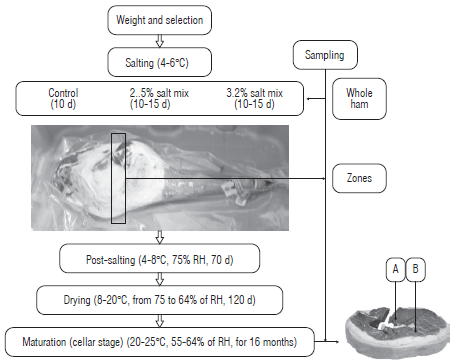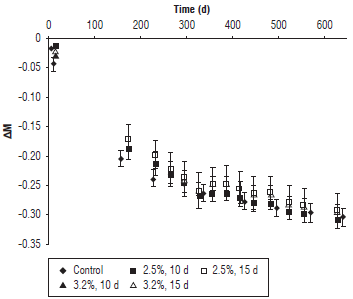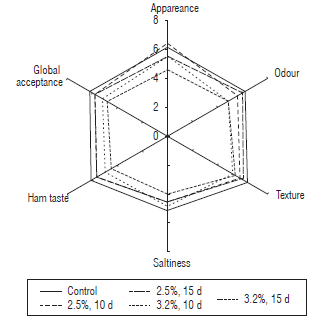Introduction
The manufacturing of dry-cured ham is a relatively simple process, but it must have specific conditions in order to ensure excellent quality. A critical point in the process is the salting stage, which generates the drying conditions and the sensory characteristics of the product (Andrés et al., 2004; Benedini et al., 2012), as well as a large amount of brine waste, whose effluents should be treated to prevent environmental pollution. In the salting stage, Serrano/ Iberian hams are covered with salt by stacking them in containers for a period of approximately 1 d kg-1 (Arboix, 2014). Excess salt is unnecessary because the salt uptake reaches a saturation point, after which the pieces are not able to incorporate more salt despite increasing the salting time. Moreover, the water released from the meat has partially dissolved NaCl, and nitrifying salts form saturated brine, whose main components are organic in nature (Barat et al., 2006). Brine production is one of the more significant environmental issues faced by many industries since brine disposal has a negative impact on the environment, is costly, and requires a high amount of energy (Randall and Lewis, 2011). The potential environmental damage from disposed brine include eutrophication, pH fluctuations, and proliferation of heavy metals in marine environments. There are different management strategies for brine disposal, including brine minimization, direct disposal, and direct reuse (Giwa et al., 2017). Currently, most of the available brine treatment options do not produce potable water that can be resold, thereby offsetting treatment costs; instead, they produce a mixed salt (waste) product that needs to be disposed of at additional costs (Randall and Nathoo, 2015). Additionally, meat products are identified as products for sodium reduction (Kloss et al., 2015). The salt content can be reduced by modifying the salting procedure according to salt uptake information (Fulladosa et al., 2015). In this regard, a fish salting methodology with low brine emission proposed by Fuentes et al. (2008) was applied for the ham salting. The methodology consists of using an exact amount of salt that is directly dosed for absorption on the lean ham surface. The combination of a curing salt mix and vacuum packaging in this controlled salting process has also been studied to obtain salt-smoked salmon for the purpose of accelerating NaCl absorption and dehydration (Rizo et al., 2013; Rizo et al., 2015). This procedure has proven to be capable of reducing waste and obtaining homogeneous products. Therefore, the aim of this study was to evaluate a salting procedure that uses high-barrier plastic bags in order to reduce brine waste production and obtain an Iberian dry-cured ham that is good quality and safe.
Materials and methods
Fifty fresh Iberian hams with an average weight of 12.8 ± 0.5 kg were selected and processed under the experiment conditions in an Iberian dry-cured ham manufacturing company. Ten hams that were used as the control were salted following the company's standard conditions. The remaining forty hams were salted employing high-barrier plastic bags (size 1300 x 750 x 0.12 mm, water vapor transmission rate 1.8 g 120 L-1 m-2 24 h-1 (23°C and 85% RH)) supplied by Productos Pilarica, S.A. (Valencia, Spain) with a vacuum application. For this purpose, the hams were randomly assigned to each treatment, in one of the two salt doses, 2.5 and 3.2% (w/w), and one of the two salting times, either 10 or 15 d (Fig. 1). In the post-salting stage, the hams were stored at between 4-8°C and 73-75% relative humidity for 70 d. In the subsequent drying stage, the hams were kept in a room under controlled conditions for 120 d; the temperature was increased from 8 to 20°C, while the relative humidity was progressively reduced to 64%. Finally, the hams were left to mature for 16 months between 20-25°C with relative humidity 55-65% (cellar stage). At the end of the process, the hams were sent to the Polytechnic University of Valencia for the physicochemical analysis and sensory evaluation.
Sampling
The sampling was carried out once the hams had reached about 30% of the total weight loss and at the end of the process. The physicochemical parameters were evaluated in the whole ham after the salting stage. At the end of the process, the analytical determinations were carried out in two zones at the widest section of the ham: zone A, located between the lean surface and near the femoral artery (Semimembranosus muscle) and zone B, near the subcutaneous fat (Biceps femoris muscle) (Fig. 1). In addition, at the end of the salting stage, the generated brine was collected, and the volume and concentration of NaCl were measured.
Analytical determinations
The moisture content (xw) was determined with oven drying to constant weight at 100°C (ISO, 1997). The fat content (xf) was established using a FOSS Soxtec System 2055 Tecator (ISO, 1973). The water activity (aw) of each sample was determined at 24°C with an Aqualab® dew point hygrometer (DECAGON Aqualab CX-2, Pullman, WA, USA). The sodium chloride was determined in both the brine and hams with an automatic chloride Analyser (Sherwood Scientific Ltd., Cambridge, UK) with the method described by Girón et al. (2015). The total sodium chloride concentration in the liquid phase (ZNaCl) was estimated from the weight fractions of water (xw) and sodium chloride (xNaCl) in accordance with Equation 1. The total weight losses of the post-salted hams were estimated from the weight (M) of the hams (at sampling time t, and 0), with Equation 2.
Color measurements were taken shortly after cutting the slice in zones A and B using a CR-410 colorimeter (Minolta Chroma Meter, Osaka, Japan) and CIE L*a*b* color system and D-65 illuminant. The texture profile analysis (TPA) was carried out following the procedure described by Aliño et al. (2010a) with double compression using a Texture Analyzer TA.XT2 (Stable MicroSystems, UK). The determinations were carried out on cubic samples (15x15x15 mm) from zones A and B; the following parameters were calculated: hardness (g), cohesiveness (dimensionless), springiness (dimensionless), adhesiveness and chewiness (g).
Microbiological analysis
The microbiological analyses were carried out after the salting stage and at the end of the process on the area closest to the bone of the central transversal section of the ham, under sterile conditions and while considering the total mesophilic aerobic flora (Cordero and Zumalacárregui, 2000), Micrococcaceae (Cordero and Zumalacárregui, 2000), salt-tolerant flora (BAM, 1998), lactic acid bacteria (ISO, 1998), Enterobacteriaceae (ISO, 2017), and sulphite-reducing clostridium (BAM, 1998). Microbial counts were obtained in duplicate, and all the results were expressed as a logarithm of colony-forming units per gram (log cfu g-1).
Sensory analysis
A sensory assessment was performed in order to evaluate the sensory acceptance of the obtained dry-cured hams. The sensory analysis was conducted with hams from each treatment. The sensory evaluation test was taken by 106 consumers: 56 women and 50 men aged between 20 and 50, all regular consumers of Iberian dry-cured ham. The tests were done with semi-structured scales (UNE-ISO, 2006), evaluating attributes such as appearance, odor, texture, intensity of saltiness, typical taste and global acceptance. These attributes were selected as being the most important and representative for dry-cured ham. Each assessor answered a questionnaire with 8 cm lines and three anchor points (0 = unpleasant, 4 = acceptable, and 8 = pleasant) for all the attributes. Each assessor evaluated five samples served at room temperature and coded with a three-digit random number.
Statistical analysis
The statistical treatment of the data was performed using Statgraphics Centurion XVI (Manugistics Inc., Rockville, MD, USA). An analysis of variance (One-Way ANOVA) was conducted for each parameter to test if there were significant differences between the samples. All of the physicochemical, microbiological, and sensory parameters were considered as dependent variables in these analyses, and the salt dose and sampling zone were the factors. The LSD procedure (least significant difference) was used to test for differences between the averages at the 5% significance level. A multifactor ANOVA was conducted with the salting parameters to evaluate the effect of the salt dose, sampling zone, and their interactions.
Results and discussion
Evaluation of the salting process
The brine production, sodium chloride content in brine, moisture, lipid content, sodium chloride, aw, sodium chloride concentration in the liquid phase, and microbial loads for the samples and the control after the salting stage are shown in table 1. There were no significant differences (P>0.05) in the production of brine when increasing the salting time or the salt dose. However, the brine production in the experiment was lower for the samples salted in plastic bags, as compared to the theoretical production of brine obtained in the traditional salting process as reported by Barat et al. (2006). Spain produces approximately 26,500 metric t of cured hams and shoulders made with the traditional method, generating a brine volume of approximately 29,818 tons. The salting method using plastic bags at 2.5 or 3.2% for 15 or 10 d would generate approximately 10,910 and 11,823 metric t of brine, respectively, representing a reduction of between 63 and 61%. In addition, when considering the amount of salt present in the brine, the differences would increase to 89% (2.5%, 15 d) and 72% (3.2%, 10 d). Brine from the traditional method is theoretically saturated (0.26 w NaCl / w brine) (Barat et al., 2006), which would generate 7,752 metric t of salt. On the other hand, the brine from the plastic bag salting under the conditions of this study was 0.074 ± 0.035 for the 2.5% salting for 15 d (2.5%-15 d) and 0.184 ± 0.050 for 3.2% for 10 d (3.2%-10 d). This represents 809 and 2,181 metric t of salt, respectively.
TABLE 1 Physicochemical parameters and microbial counting (log cfu g-1) of the brine and hams after the salting stage. Mean values ± SD.
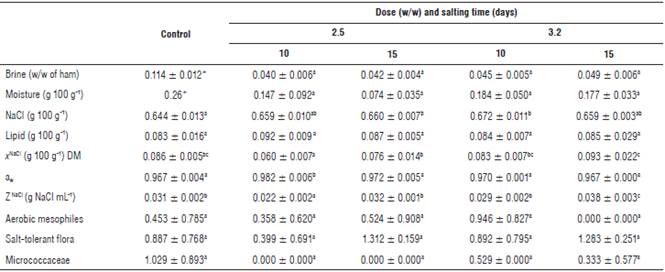
Means in a row with different letters are significantly different (P<0.05); Data obtained from Barat et al. (2006).
Physicochemical characterization of the samples after the salting stage
The evaluated parameters in the samples after the salting stage showed significant differences (P<0.05) between the control and the treatments for moisture, salt content and water activity. The hams salted at 2.5%-15 d and 3.2%-10 d presented the highest values of moisture. The salt content presented the lower values for treatment 2.5%-10 d (0.060 ± 0.007 w/w) when the salt content was expressed as salt into the liquid phase (ZNaCl); the hams salted at 3.2%-15d had significant differences (P<0.05) because of their higher salt concentration (0.038 ± 0.003), as compared to the control (0.031 ± 0.002). The water activity values were inversely related to ZNaCl, with greater or lesser aw values of the hams related to greater or lesser ZNaCl values. For aw, the hams salted at 2.5%-10 d presented the higher values (0.982 ± 0.006). The fat content and microbiological counts did not show significant differences (P<0.05). The fat values are similar to those reported by other authors in studies on Iberian dry-cured ham (Aliño et al., 2010b). The values obtained in the microbiological determinations for aerobic mesophilic, salt-tolerant flora and micrococcaceae, but not for the isolation of lactic acid bacteria, Enterobacteriaceae and sulphite-reducing clostridium, indicated a good level of hygiene in the raw material and the salting process.
Evaluation of the hams' mass variation throughout the processing
There were significant differences (P<0.05) for the changes in total mass (Fig. 2). The control exhibited a greater reduction than the hams salted at 2.5 and 3.2% for either 10 or 15 d after the salting stage; the result was consistent with changes in moisture and brine. Nevertheless, the water content was released along the drying stage. Therefore, the differences were reduced during the processing. At the end of the process, no significant differences (P>0.05) were observed between the treatments and the control; the accumulated weight losses (AM) exhibited an average value of -0.031 ± 0.02 for all of the hams.
Physicochemical characterization of dry-cured hams
There were no significant differences (P>0.05) for moisture content (xw, w/w) or salt content (xNaCl DM) between zones A and B of the samples and the control (Fig. 3). The moisture content in the outer sampling zone (A) of the hams presented lower values than the inner zone (B); these results were expected because the outer zone is directly in contact with the salt. The moisture values agree with those established by other authors (Garrido-Novel et al., 2015).
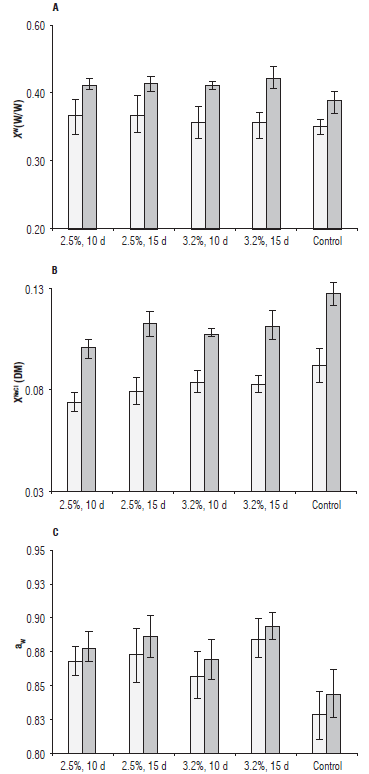
FIGURE 3 Mean values ± standard deviation of water content (xw w/w), salt content on a dry matter basis (XNaCl DM), and water activity in the sample zones A (lean surface, white bars) and B (inner point, black bars) at the end of the process.
The salt content values showed that the traditionally salted hams presented higher levels of sodium chloride than the hams salted in plastic bags. As expected, the salt content in the outer zone (A) presented lower values than in the inner zone (B) because salt diffuses to the zones with a greater amount of water (Aliño et al., 2010a). The highest salt contents were found in the control and the hams salted at 3.2% for 15 d. The water activity presented significant differences (P<0.05) with lower values in the outer zone (A) for all of the treatments and the control, which exhibited the lowest aw values.
The multifactor ANOVA (Tab. 2) revealed that the amount of salt dosed and the sampling zone influenced the moisture and salt content. The effect of the sampling zone was greater as compared to the salt dose for all of the considered variables. The interactions between salt and zone did not affect the studied variables. Nevertheless, the effect of the interactions was less important than the factors considered individually.
Texture and color analysis
There were no significant differences (P>0.05) between the treatments and the control for the TPA analysis (Tab. 3). On the other hand, it was observed that the lower moisture content in the control promoted higher values for hardness, chewiness and cohesiveness. However, these values may not be important at the consumption level because ham is consumed in slices and not in cubes. The results for the inner zone (B) did not show significant differences (P>0.05) between the treatments and the control; the values were similar for the texture attributes, except for the samples at 2.5% for 10 d, which presented a softer texture. Other authors (Gou et al., 2008; Andronikov et al., 2013) have found that a lower salt content in ham promotes proteolysis, which results in a softer texture in the final product (Gou et al., 2008; Andronikov et al., 2013).
TABLE 3 Mean values ± standard deviation of the texture parameters: hardness (g), chewiness (g), springiness, cohesiveness and adhesiveness in the Semimembranosus muscle (outer zone: A) and in the Biceps femoris muscle (inner zone: B) of the ham.
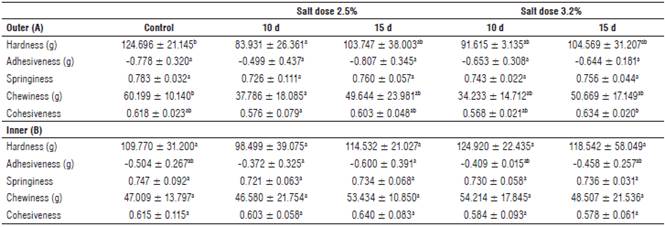
Means in a row with different letters are significantly different (P<0.05)
The color parameters did not show significant differences (P>0.05) between the treatments and the control (Tab. 4). The mean values for luminosity and yellowness were similar in the two sampling zones for all of the treatments and the control. Higher values for redness were observed for the samples salted at 3.2% for 15 d in both zones, which may have been due to the pH, salt concentration and moisture loss, which raised the pigment concentrations, such as myoglobin (Sanabria et al., 2004; Bermudez et al., 2014)
Sensory analysis of dry-cured hams
The overall scores marked by the assessors of the sensory attributes of the different evaluated samples are shown in figure 4. There were significant differences (P<0.05) between the samples for the evaluated attributes. The hams with lower acceptance rates were those salted with the highest concentration of salt; the treatment at 3.2% for 15 d presented the lowest acceptability; the hams presented similar behavior when salted at 3.2% for 10 d, except for the score of appearance and saltiness. The observed result can be attributed to the formation of a crust on the hams' surface, which was salted with a higher salt dose, affecting the diffusion process and consequently deteriorating the organoleptic characteristics of the hams at the end of the process (Martínez-Onandi et al., 2016). On the other hand, the hams salted with a lower salt dose facilitated the diffusion process and improved their acceptance. In addition, it is important to emphasize that Spanish consumers highly value the salty taste of ham (Morales et al., 2013), which influenced the preference for the control over the other treatments.
Conclusions
The assessed methodology minimizes and reduces brine waste. Moreover, it provides hams with a lower salt content. The employed salt levels exhibited similar levels for the reference values for the physicochemical parameters. Among the salt doses, some samples with 3.2% (w/w) presented crust hardening, while the samples with the 2.5% salt dose presented acceptance close to the control. However, consumers should be made aware of the importance of reducing salt uptake, which is often high in cured products. Further research should be done in order to replicate the proposed methodology using biodegradable or reusable plastic bags or plastic or metal containers that can be used in the production line to make the whole productive process more environmentally friendly.













